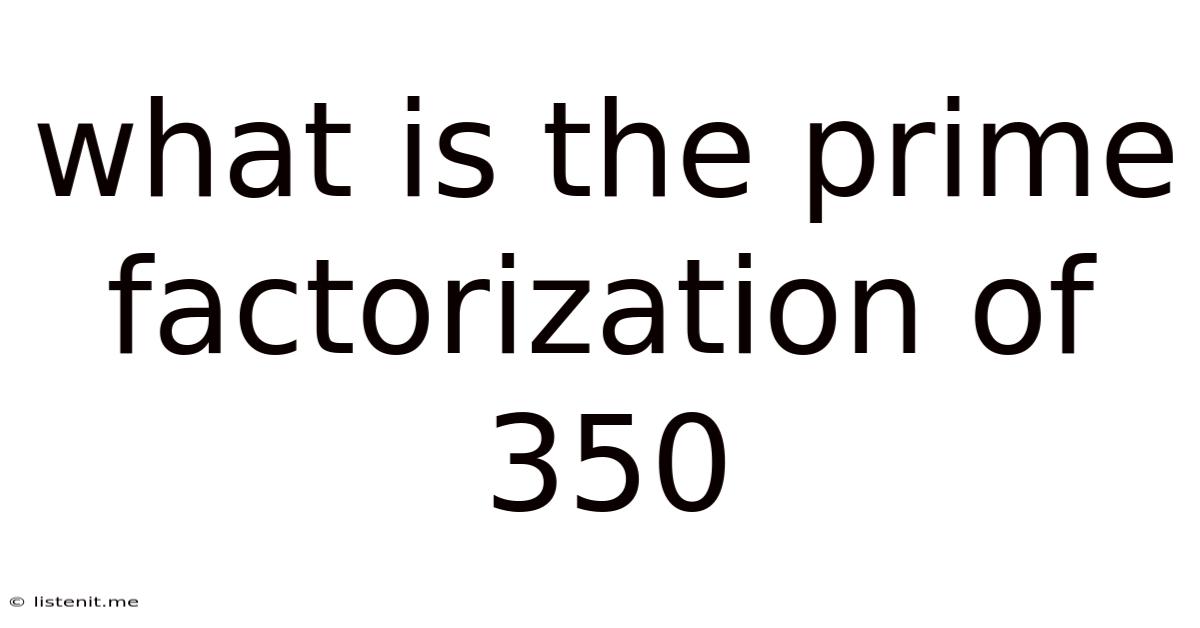What Is The Prime Factorization Of 350
listenit
May 12, 2025 · 5 min read

Table of Contents
What is the Prime Factorization of 350? A Deep Dive into Prime Numbers and Factorization
Finding the prime factorization of a number might seem like a simple mathematical exercise, but it's a fundamental concept with far-reaching applications in number theory, cryptography, and computer science. This article delves into the prime factorization of 350, explaining the process step-by-step and exploring the broader context of prime numbers and factorization. We'll also touch upon the significance of prime factorization in more advanced mathematical fields.
Understanding Prime Numbers
Before we tackle the factorization of 350, let's solidify our understanding of prime numbers. A prime number is a natural number greater than 1 that has no positive divisors other than 1 and itself. This means it cannot be expressed as a product of two smaller natural numbers. The first few prime numbers are 2, 3, 5, 7, 11, 13, and so on. The number 1 is not considered a prime number. This seemingly simple definition underpins much of modern number theory.
The Importance of Prime Numbers
Prime numbers are considered the "building blocks" of all other natural numbers. This is because of the Fundamental Theorem of Arithmetic, which states that every integer greater than 1 can be represented uniquely as a product of prime numbers, disregarding the order of the factors. This unique representation is crucial in various mathematical and computational applications.
Finding the Prime Factorization of 350
Now, let's determine the prime factorization of 350. We'll use a method known as the factor tree. This is a visual method that helps systematically break down a number into its prime factors.
-
Start with the original number: 350
-
Find the smallest prime factor: The smallest prime number is 2. Since 350 is an even number, it's divisible by 2. Divide 350 by 2: 350 / 2 = 175
-
Continue factoring: Now we have 2 and 175. 175 is not divisible by 2. Let's try the next prime number, 3. 175 is not divisible by 3 (1+7+5 = 13, which is not divisible by 3). Let's try 5. 175 is divisible by 5: 175 / 5 = 35
-
Further breakdown: We now have 2, 5, and 35. 35 is also divisible by 5: 35 / 5 = 7
-
Prime Factor Achieved: We're left with 2, 5, 5, and 7. All of these numbers are prime numbers. We've reached the end of our factor tree.
Therefore, the prime factorization of 350 is 2 x 5 x 5 x 7, which can also be written as 2 x 5² x 7.
Visualizing the Factor Tree for 350
Here's a visual representation of the factor tree:
350
/ \
2 175
/ \
5 35
/ \
5 7
This clearly shows the process of breaking down 350 into its constituent prime factors.
Alternative Methods for Prime Factorization
While the factor tree is a visually intuitive method, other techniques can also be used to find the prime factorization of a number. These include:
-
Repeated Division: Continuously divide the number by the smallest prime number that divides it evenly until you are left with 1. This method is particularly efficient for larger numbers.
-
Using a Prime Factorization Calculator: Many online calculators and software packages can quickly calculate the prime factorization of any number. However, understanding the underlying process is crucial for a deeper grasp of the concept.
Applications of Prime Factorization
The seemingly simple process of prime factorization has profound implications across various fields:
1. Cryptography:
Prime factorization is the cornerstone of many modern encryption algorithms, such as RSA. The security of these algorithms relies on the difficulty of factoring extremely large numbers into their prime factors. The computational power required to factorize such numbers is immense, making it extremely challenging to break the encryption.
2. Number Theory:
Prime factorization is fundamental in number theory, providing insights into the structure and properties of integers. Concepts like modular arithmetic, which is crucial in cryptography, rely heavily on prime factorization.
3. Computer Science:
Prime factorization plays a role in various algorithms in computer science, including primality testing, which determines whether a given number is prime. Efficient algorithms for prime factorization are constantly being researched and improved.
4. Mathematics Education:
Understanding prime factorization helps build a strong foundation in number theory and related mathematical concepts. It fosters critical thinking and problem-solving skills.
Beyond 350: Exploring Larger Numbers
While we've focused on 350, the principles discussed apply to any natural number greater than 1. Factoring larger numbers can be more computationally intensive, but the underlying methodology remains the same: repeatedly dividing by prime numbers until only prime factors remain. For very large numbers, sophisticated algorithms are employed to speed up the process.
Conclusion: The Significance of Prime Factorization
The prime factorization of 350, 2 x 5² x 7, might appear to be a simple result. However, this seemingly basic concept underpins significant advancements in cryptography, number theory, and computer science. Understanding prime factorization not only enhances your mathematical skills but also provides a glimpse into the elegant structure and profound implications of prime numbers in the world of mathematics and beyond. The ability to efficiently find the prime factorization of a number is a testament to the power of mathematical reasoning and its practical application in various fields. From securing online transactions to developing advanced algorithms, the seemingly simple act of factoring a number like 350 holds significant weight in our modern technological landscape.
Latest Posts
Related Post
Thank you for visiting our website which covers about What Is The Prime Factorization Of 350 . We hope the information provided has been useful to you. Feel free to contact us if you have any questions or need further assistance. See you next time and don't miss to bookmark.